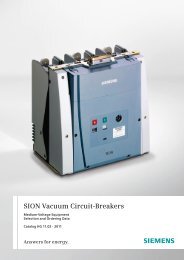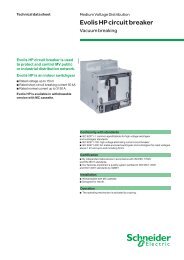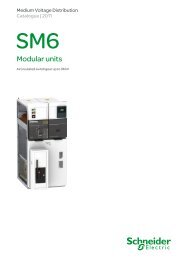Catalogue Security Technology
Catalogue Security Technology
Catalogue Security Technology
You also want an ePaper? Increase the reach of your titles
YUMPU automatically turns print PDFs into web optimized ePapers that Google loves.
What means......?<br />
AES<br />
Auto Electronic Shutter<br />
Normally, the CCD chip in video cameras is exposed for 1/50th of a second and then<br />
read out. Since CCDs are very sensitive to light, the sensor would quickly be overexposed<br />
in strong light and the output signal rendered unusable. Therefore, either<br />
the amount of light to the sensor must be reduced by a shutter in the lens or the<br />
exposure time of the sensor reduced. The electronic shutter shortens the effective<br />
exposure time of the CCD up to 1/100,000th of a second<br />
AGC<br />
Automatic Gain Control<br />
In contrast to a shutter, the automatic gain control is active in poor lighting conditions.<br />
A control voltage is obtained from the image which controls the CCD signal<br />
gain depending on the brightness level so as to provide a constant video signal on<br />
the monitor. A negative aspect is that the CCD noise is amplified with increasing<br />
gain, which is where AGC has its limitations.<br />
For some applications, it may be necessary to deactivate the automatic gain control,<br />
for example, small bright objects on a dark background (astronomy). In this case,<br />
the AGC would greatly intensify the relatively dark image and overamplify the small<br />
bright object.<br />
BLC<br />
Back Light Compensation<br />
Where there are strong contrasts, for example, a bright background or bright window<br />
in the visual field of a camera, other objects are often difficult to distinguish.<br />
The BLC can reduce this effect.<br />
DNR<br />
Digital Noise Reduction<br />
This function effectively suppresses image noise which occurs in poor lighting<br />
conditions. Noise reduction generally takes place in that the signal processor in the<br />
camera places several individual images one on top of the other. This reduces the<br />
image noise and amplifies the image information, however rapid movements can<br />
look slightly blurred or fuzzy in the image.<br />
DSP<br />
Digital Signal Processor<br />
These cameras use a digital signal processor to internally process the signals from<br />
the CCD chip. The presence of such a DSP generally says little about a camera‘s<br />
performance. Decisive are the computing capacity (speed) of the DSP and programming.<br />
The performance of DSPs is measured in MIPS (Million Instructions Per<br />
Second).<br />
WDR<br />
Wide Dynamic Range<br />
The wide dynamic function allows the display of image contents with strongly<br />
varying brightness levels. Conventional CCD cameras have a linear dynamic range<br />
and therefore do not have the same level of perception as the human eye, which<br />
can recognise contrast levels as high as 1000:1. Humans therefore can be in a room<br />
with an illumination level of 100 lux, for example, and see through a window with an<br />
illumination level of 100,000 lux at the same time.<br />
In surveillance practice, there are often situations where observations are made with<br />
strong differences in contrast (for example, cars driving with full beam at night). WDR<br />
cameras use a technology by means of which they store images with different exposure<br />
times for the light and dark areas in their memory. A high-performance DSP is<br />
able to generate from these images an image with a much higher dynamic range.<br />
AI<br />
Auto Iris<br />
These cameras offer the possibility to connect auto iris lenses. With these types of<br />
lenses, the electronic shutter of the camera is switched off and the brightness controlled<br />
by an electromechanically operated shutter. Distinction is made here between<br />
lenses that automatically obtain their control voltage directly from the video signal<br />
of the camera (video drive) or lenses that only have an electromechanical shutter<br />
drive (DC drive). In the case of the latter, the control voltage is generated in the camera.<br />
A special connector is provided on the camera body for electrical connection<br />
to the lens. To be noted is that the pin assignments of this connector differ with both<br />
types of lenses.<br />
DC<br />
Connector for DC Drive Lenses<br />
For cameras with this option, DC controlled auto iris lenses can be used. In the case<br />
of these lenses, the shutter is controlled electromechanically by the camera. The<br />
background brightness is adjusted with a control on the camera.<br />
C/CS-Mount<br />
C/CS-Mount Lens Thread<br />
This is a standard lens mounting thread. These screw threads have a diameter of<br />
1 inch (25.4 mm) and a pitch of 1/32 inch (0.79 mm). The difference between a C and<br />
CS-mount is the flange focal length, i.e. the distance from the mounting flange to<br />
the imaging plane (CCD sensor). For a C-mount this is 17.52 mm and for a CS-mount<br />
12.52 mm. Our cameras all have a CS-mount flange focal length; C-mount lenses can<br />
be mounted with a 5 mm thick extension tube (included).<br />
Our general sales and delivery conditions you find at www.efb-elektronik.de


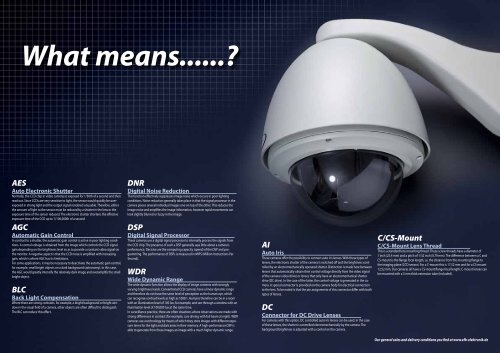
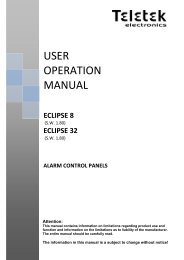
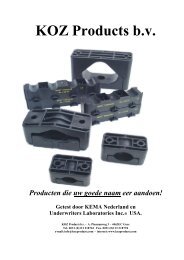
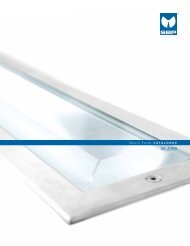
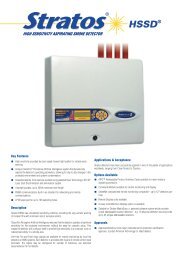
![Data Center Solutions [EN011] ZPAS - SLO Latvia](https://img.yumpu.com/15723906/1/185x260/data-center-solutions-en011-zpas-slo-latvia.jpg?quality=85)
